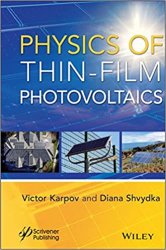Physics of Thin-Film Photovoltaics
- Добавил: alex66
- Дата: 13-11-2021, 21:44
- Комментариев: 0

Название: Physics of Thin-Film Photovoltaics
Автор: Victor Karpov and Diana Shvydka
Издательство: Scrivener Publishing
Год: 2022
Страниц: 288
Размер: 22,74 МБ
Формат: PDF
Язык: English
It appears rather paradoxical that thin-film photovoltaics (PVs) are made of materials that seem unacceptable from the classical PV perspective, and yet they often outperform classical PV. This exciting new volume solves that paradox by switching to a new physics paradigm.
Many concepts here fall beyond the classical PV scope. The differences lie in device thinness (microns instead of millimeters) and morphology (non-crystalline instead of crystalline). In such structures, the charge carriers can reach electrodes without recombination. On the other hand, thin disordered structures render a possibility of detrimental lateral nonuniformities (“recombination highways”), and their energy spectra give rise to new recombination modes. The mechanisms of thermal exchange and device degradation are correspondingly unique.
The overall objective of this book is to give a self-contained in-depth discussion of the physics of thin-film systems in a manner accessible to both researchers and students. It covers most aspects of the physics of thin-film PV, including device operations, material structure and parameters, thin-film junction formation, analytical and numerical modeling, concepts of large area effects and lateral non-uniformities, physics of shunting (both shunt growth and effects), and device degradation. Also, it reviews a variety of physical diagnostic techniques proven with thin-film PV. Whether for the veteran engineer or the student, this is a must-have for any library.
This outstanding new volume:
Covers not only the state-of-the-art of thin-film photovoltaics, but also the basics, making this volume useful not just to the veteran engineer, but the new-hire or student as well
Offers a comprehensive coverage of thin-film photovoltaics, including operations, modeling, non-uniformities, piezo-effects, and degradation
Includes novel concepts and applications never presented in book format before
Is an essential reference, not just for the engineer, scientist, and student, but the unassuming level of presentation also makes it accessible to readers with a limited physics background
Is filled with workable examples and designs that are helpful for practical applications
Is useful as a textbook for researchers, students, and faculty for understanding new ideas in this rapidly emerging field
Audience:
Industrial professionals in photovoltaics, such as engineers, managers, research and development staff, technicians, government and private research labs; also academic and research universities, such as physics, chemistry, and electrical engineering departments, and graduate and undergraduate students studying electronic devices, semiconductors, and energy disciplines
Внимание
Уважаемый посетитель, Вы зашли на сайт как незарегистрированный пользователь.
Мы рекомендуем Вам зарегистрироваться либо войти на сайт под своим именем.
Уважаемый посетитель, Вы зашли на сайт как незарегистрированный пользователь.
Мы рекомендуем Вам зарегистрироваться либо войти на сайт под своим именем.
Информация
Посетители, находящиеся в группе Гости, не могут оставлять комментарии к данной публикации.
Посетители, находящиеся в группе Гости, не могут оставлять комментарии к данной публикации.
